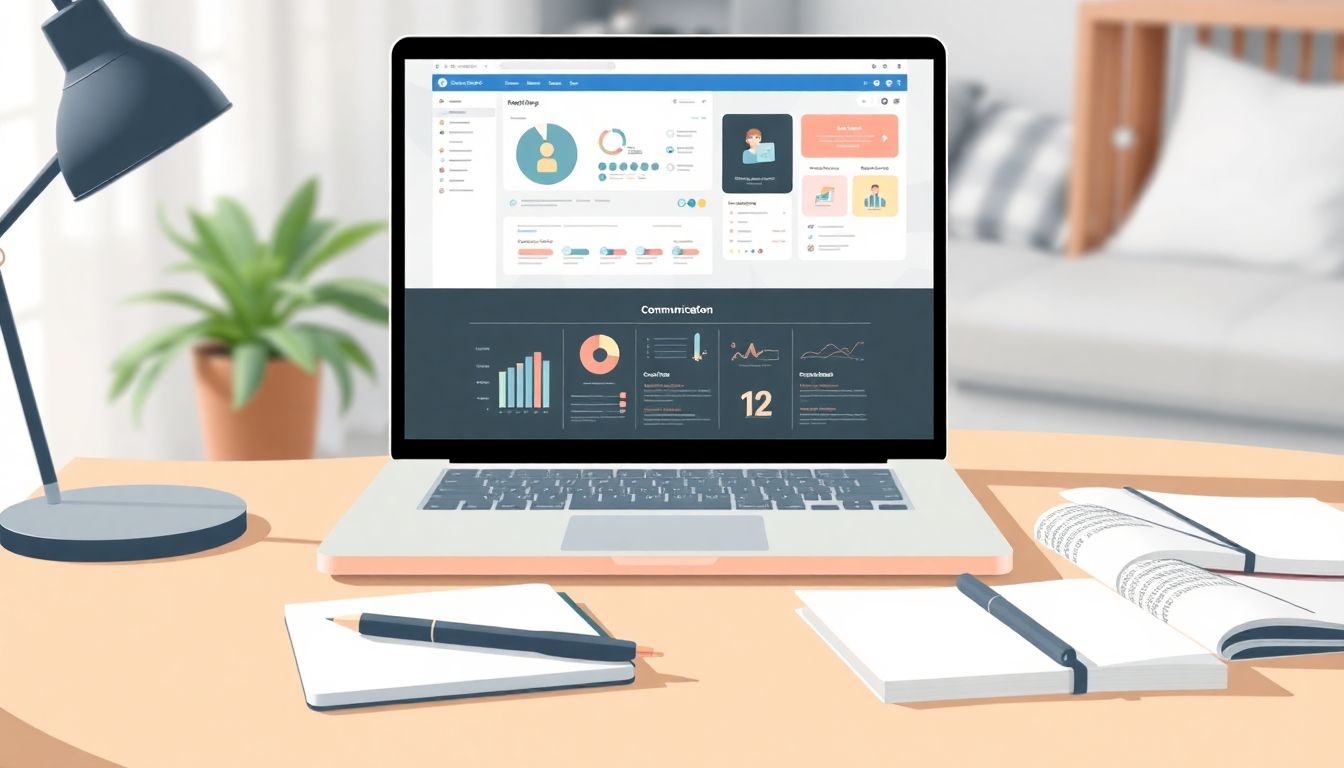Creating an internal communications plan can feel like trying to solve a Rubik’s cube blindfolded. You know it’s important, but where do you even start? You’re definitely not alone in wondering how to keep everyone in the loop and engaged without it becoming a chore.
Imagine having a treasure trove of prompts that not only help you craft clear messages but also resonate with your team. Stick around, and I’ll share some fantastic ideas that can transform your communication strategy from a hassle into a breeze.
From drafting newsletters to crisis communication, we’re diving into all the essential prompts you need. Get ready to elevate your internal communications game!
Key Takeaways
- Start by outlining a strategic communication framework that aligns with your organization’s goals.
- Tailor messages to different employee segments for more effective communication.
- Create engaging internal newsletters with a mix of updates and employee recognition.
- Define clear SMART communication goals that help measure success and accountability.
- Gather employee feedback to improve communication processes and encourage open dialogue.
- Develop a crisis communication plan to ensure timely and effective messaging during emergencies.
- Encourage team collaboration by promoting communication tools and establishing a supportive culture.

Key ChatGPT Prompts for Effective Internal Communications Plans
Crafting effective internal communications plans is crucial for employee engagement and overall organizational success.
Utilizing well-structured prompts for ChatGPT can help streamline this process and enhance clarity in communication.
Here, we will explore several practical ChatGPT prompts that focus on developing a communication strategy, crafting messages for diverse audiences, designing internal newsletters, and managing the overall communication approach.
Prompts for Developing a Communication Strategy
A successful communication strategy lays the groundwork for how information flows within an organization.
To create a focused communication strategy, consider using the following prompts with ChatGPT:
- “Outline a strategic communication framework for our organization, focusing on stakeholder expectations and messaging objectives.”
- “Help me identify audience segments for our internal communication and suggest tailored approaches for each.”
- “Create a list of best practices for aligning our communication strategies with organizational goals and values.”
- “Suggest metrics for measuring the effectiveness of our communication strategy.”
- “Draft a plan for regular communication reviews to ensure continuous alignment with our strategic objectives.”
Prompts for Creating Messages for Different Audiences
Not all employees respond to the same messaging, so tailoring communication is key.
Here are some prompts to guide you in crafting targeted messages:
- “Analyze our employee audience. What are the key characteristics and preferences to consider for effective communication?”
- “Draft communications in different tones for our management, mid-level staff, and entry-level employees.”
- “Create stories that resonate with each demographic in our workforce. Focus on their needs and interests.”
- “List examples of adaptable messaging strategies that will suit various departments within our organization.”
- “Provide feedback on current messaging and how it can be more aligned with our employees’ interests.”
Prompts for Crafting Internal Newsletters
Internal newsletters are excellent tools for keeping employees informed and engaged.
To make the most of your newsletters, use these prompts:
- “Generate ideas for engaging content for our next internal newsletter that balances updates and employee recognition.”
- “Suggest innovative formats and layouts that can make our internal newsletter more visually appealing and readable.”
- “Outline a distribution strategy that ensures our newsletter reaches all employees effectively.”
- “Identify best practices for writing concise and engaging headlines for our internal newsletter articles.”
- “Share tools and resources that can help streamline our newsletter production process.”
As you explore these prompts, keep in mind the value of consistent and clear communication. For more insights on leveraging prompts, check out our posts on ChatGPT for Education and ChatGPT for Small Businesses. These resources can provide additional context when developing your internal communications strategy.

Prompts for Setting Communication Goals
Defining clear communication goals is essential for accountability and success.
Setting these goals helps ensure your messaging is purposeful and measurable.
Use these ChatGPT prompts to guide your process in establishing communication goals:
- “List five SMART communication objectives for enhancing employee engagement in our organization.”
- “Identify key performance indicators (KPIs) we can use to evaluate our internal communications plan.”
- “Draft a framework for setting communication goals that align with our overall business strategy.”
- “Provide examples of baseline measurements we can track to assess improvement in our communication efforts.”
- “Suggest accountability measures for team members involved in communication planning and execution.”
Prompts for Gathering Employee Feedback
Obtaining employee feedback is crucial for understanding how well your communication efforts are resonating.
Gathering insights from employees helps improve future strategies and fosters a culture of open communication.
Here are compelling prompts to gather effective employee feedback:
- “Create a set of effective survey questions that measure employee satisfaction with internal communication.”
- “Suggest various methods for collecting employee feedback, including anonymous options.”
- “Outline a process for analyzing and acting upon employee feedback to enhance engagement.”
- “Propose ways to cultivate a feedback culture within our organization that encourages open dialogue.”
- “List tools or platforms we can use for gathering and organizing employee insights effectively.”
Prompts for Crisis Communication Planning
In times of crisis, having a solid communication plan in place can significantly mitigate risks and manage perception.
This plan should be proactive and adaptable to rapidly changing situations.
Utilize these prompts to develop a comprehensive crisis communication strategy:
- “Draft a crisis communication framework that outlines key stakeholders and communication protocols.”
- “Identify specific communication strategies we can employ during a crisis to maintain transparency.”
- “List the key differences between proactive and reactive communication in crisis management.”
- “Outline communication channels we should use during emergencies to ensure timely updates reach all employees.”
- “Suggest steps for post-crisis evaluation and the importance of learning from the experience.”
Prompts for Encouraging Team Collaboration
Fostering collaboration within teams can lead to increased creativity and improved outcomes.
By leveraging effective communication tools, you can enhance teamwork across departments.
Explore these prompts to encourage team collaboration:
- “Brainstorm collaborative communication techniques that promote teamwork in our organization.”
- “Highlight tools or platforms we can implement to support remote collaboration among teams.”
- “Suggest practices for establishing a collaborative culture that embraces feedback and support.”
- “Identify best practices for facilitating cross-functional team meetings to maximize productivity.”
- “Propose team-building communication strategies that enhance relationships and trust among colleagues.”

Prompts for Measuring Communication Effectiveness
Understanding how effective your communication efforts are is crucial for continual improvement.
Measuring communication effectiveness allows you to see what’s working and what needs adjustment.
Utilize these prompts to get actionable insights on measuring your communication strategies:
- “List the key metrics we should track to assess the effectiveness of our internal communication efforts.”
- “Draft a communication audit checklist that evaluates our messaging and channels.”
- “Suggest a process for gathering data on communication impact across various teams.”
- “Provide examples of assessment tools that can help us analyze employee engagement with our messages.”
- “Outline a strategy for benchmarking our communication effectiveness against industry standards.”
Prompts for Enhancing Remote Team Communication
With remote work on the rise, enhancing communication among virtual teams is more important than ever.
Utilizing efficient communication tools and practices can help maintain connection and productivity.
Here are some prompts to fine-tune your remote team communication:
- “List best practices for maintaining clear communication among remote team members.”
- “Recommend digital tools and platforms that enhance virtual collaboration and engagement.”
- “Create strategies for regular check-ins that keep team members connected despite distance.”
- “Suggest methods for overcoming common remote communication challenges, such as time zone differences.”
- “Draft a plan for combining asynchronous and synchronous communication in a remote setting.”
Prompts for Regular Updates to Management
Regular communication with management keeps leadership informed and engaged with the team’s progress.
Effective updates can showcase the impact of communication efforts and align with organizational goals.
Consider these prompts for crafting compelling updates for your management team:
- “Outline a standard reporting format that effectively communicates key updates to management.”
- “Provide ideas for the types of information that should be included in regular leadership updates.”
- “Suggest how often we should provide updates to management and what frequency works best.”
- “Create an approach for succinctly communicating complex information to leadership.”
- “Draft a template for ensuring our updates align with overall organizational objectives.”
FAQs
Key prompts include identifying your objectives, understanding your audience, determining key messages, and selecting appropriate channels to ensure clear and effective communication across all levels of the organization.
Effective internal newsletters should feature concise updates, highlight employee achievements, include relevant news, and encourage contributions from various teams to foster engagement and a sense of community within the organization.
Prompts can include targeted surveys, feedback forms, one-on-one meetings, and open forums. It’s crucial to create a safe space for honest input, ensuring employees feel their voices are valued and taken seriously.
Effective crisis communication planning involves establishing a clear protocol, identifying key stakeholders, preparing messages in advance, and ensuring rapid communication to mitigate misinformation and maintain trust during a crisis.
